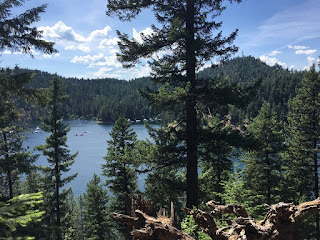Today's post marks the 1,000th entry in the Palouse Wargaming Journal (PWJ). In September 2012, the PWJ started as an aid in documenting my wargaming activities. A couple of my regular gaming comrades were blogging about their hobby activities so why not I? When the PWJ reached the 500th blog post nearly four years ago, I reflected back upon that 2012 launch (see 500/5,000 Drawing). Now, after a 1,000 entries, my expectations seem well-defined.
I wanted the PWJ to become a place in which my hobby activities could be logged, archived, and tracked to provide some motivation for myself and as a handy reference resource. Blogging as a self-motivational tool, for me, works. Especially useful in keeping my work on track is the annual Project Planning post in which I guess where my efforts may be headed and plot a way to reach those goals. Often successfully!
Some of my concerns when diving into the blogosphere in 2012 were:
- Would I run out of ideas and content?
- Would the novelty of blogging wear off as a passing fad?
- Would anyone else find my work interesting or mildly entertaining?
- Could I make a small contribution to the body of wargaming?
- Would the effort required to maintain a blog quickly dampen my enthusiasm for the painting armies, reading, and wargaming?
Upon reaching 1,000 posts, I can say with certainty that I have not exhausted all ideas for blog posts. I thought material would run out long before mow. If anything, many more ideas and topics surface than I have time to consider. There is a moderately sized list of draft posts on topics yet to be worked. When an idea pops into my head, I make a note in the draft post folder with just enough detail to help resurrect the topic if needed. Some day, I may revisit some of these topics that once triggered an interest. Others will remain as skeletal reminders.
A thousand posts later, I have lost no enthusiasm for continuing. For me, blogging was no novelty. The PWJ has settled into a seemingly sustainable routine of a post every three days. Often I am surprised that I can maintain this pace in a busy world but it is usually not difficult. Slowing publication frequency has been considered but the ten posts per month works and provides a regular outlet for reflection and thoughtful organization. The act of writing, like painting, is therapeutic.
Speaking of painting, since 2012, more than 8,000 figures have crossed the painting desk; many have been featured here. What about the remainder of the blog content? Besides painting, which represents the largest component of content, battle reports, boardgaming, scenario design, reviews, travel, and cycling fill in where needed. While I try to keep travel posts historically oriented, I do drift off. That is ok. My family appreciates seeing our travels documented. Cycling may seem an odd fit into a wargaming blog but it is reassuring to see comments when I do post a bit on my cycling routine. Who knew that a number of wargamers cycle as well? Another common bond!
Besides the standard blog fare of parading painted figures and battle reports, I have ideas for a few other wargaming related topics to add into the mix on a semi-regular basis. These semi-regular, serial entries have not progressed beyond a few thoughts but I expect one or two of these to begin filtering into the publishing routine before the end of summer.
While I find many benefits to sharing my thoughts and projects in a public forum, the commentary received in response to my posts is one of the biggest rewards to blogging. Every post exposes oneself to possible criticism. I do consider this possibility before pressing "Publish." A risk to take, for sure, especially in today's world. However, almost without exception all comments are supportive, offer encouragement, and provide much motivation to forge on with this work. Please keep the commentary coming. Each reader's response is appreciated and strengthens to reinforce the bond between author and audience. The Top Commentators widget is, indeed, a Wall of Fame. Your participation is greatly appreciated. Even more so now than 500 posts ago, I count the frequent contributors as friends. I look forward to a day I can face these gentlemen on the field of battle. For a very few, this has been a reality. For others, this might be possibility.
What no contest to celebrate this milestone? Well, I considered a prize drawing, for sure. The last few contests have had fewer participants and a number of readers opted out. Perhaps many find themselves in a situation similar to my own. I am running out of storage space and being enveloped in wargaming paraphernalia. No room even for free stuff!
Thanks for reading and contributing to the PWJ. As always, reader participation is much appreciated. Blogging would not be nearly as rewarding without reader support. We soon return to regularly scheduled programming as post #1,001 is being prepared.














































